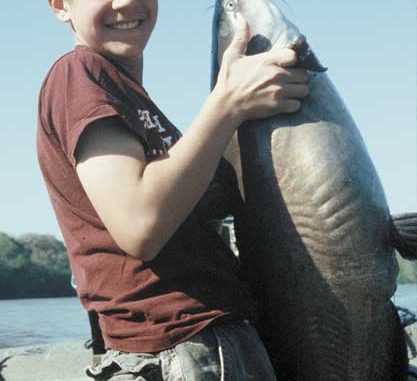
A Pee Dee River guide holds the key to a seldom-fished stretch of water that’s N.C.’s version of catfish heaven
Tar Heel basketball fans may envision paradise in shades of blue, but catfishermen have their own blue heaven on earth near Wadesboro.
This watery paradise, teeming with blue catfish weighing as much as 70 pounds and the average catfish weighing 30 pounds, consists of a 25-mile stretch of the Pee Dee River between the U.S. Highway 74 bridge near Wadesboro and the North Carolina-South Carolina border.
Along this rippling water that divides Anson and Richmond counties, anglers rarely see other fishing boats and never encounter high-powered recreational crafts or annoying jet skis. On rare occasions, they may spy a lone kayaker or canoeist.
In fact, few anglers are privy to this catfish mecca because this segment of the Pee Dee River meanders through private property where only a handful of fishermen may enter.
One such fortunate person is Robbie Burr of Pee Dee Guide Service, the one and only guide with access to these treasured waters.
Burr said this part of the Pee Dee River was transformed into a catfisherman’s dream through an event that never transpired.
“In the 1940s, Progress Energy bought 10,000 acres on both sides of the river with the intention of constructing another lake,” Burr said.
“For some reason, the lake was never built, and Progress Energy turned the land over as designated (N.C. Wildlife Resources Commission) Game Land, which was open to the public.
“Eventually, the riverside property was removed as Game Land, and tracts were sold to individuals and to hunting clubs.
“As a result, the 25-mile stretch of river now runs along private property with no public access. The closest public access is at the Highway 74 bridge, but getting from there to here by boat is almost impossible because of the rocky shoals and shallow water. The next public access is across the line in South Carolina.”
Burr has access to the river through his affiliation with a local club and literally holds the key to paradise. To reach the river, he has to unlock a gate and drive down a dirt road to a small ramp of his own making.
“I had to spend my own money and build my own ramp in order to fish the river,” said Burr, who lives near Blewett Falls dam.
However, getting to paradise is one thing; motoring about in it is another.
Burr had to modify a 20-foot-long G-3 boat to navigate the river. He removed the front and rear consoles to evenly distribute the weight of the boat so it would lie flat to avoid having a deeper portion that could strike a rock.
“My boat sits 5-inches deep in the water, plus I have a jet motor with a hydraulic jack plate to help me maneuver around the rocks,” said Burr, who tore up several conventional boats and motors before adapting his mode of transportation to the treacherous whims of this stretch of water.
The catfishing at this river paradise is worth all the aggravation Burr experienced just to fish it.
Burr said flatheads once were more prevalent in the river than blue cats, but in the ‘70s blues were introduced, and they gradually became the dominant species.
“People don’t realize how many big blues are in this river,” said Burr, whose two biggest blues weighed 72 and 74 pounds.
“There are lots of 50- and 60-pound catfish in here,” he said. “On a good day, a fisherman should be able to catch 15 cats that weigh between 500 and 600 pounds.”
A former bass tournament angler, Burr became so mesmerized about catching big blues, he gave up tournament fishing and sold the 85 bass fishing rods he’d collected.
“I started catching big blues about 5 years ago and decided to devote all of my free time fishing for them,” said Burr, whose job as a forestry consultant gives him flexible working hours.
Burr said September and October are the worst months for catching blues at the river. The winter months and early spring are excellent times for blues while the flatheads bite better in the summer.
But summer fishing is difficult at the river because when the water isn’t being pulled, moss grows on the surface of the river, making bait presentations almost impossible.
The big blues get ready to spawn by the first of May and move upstream, but the shallow water and numerous rocky shoals block their movement. These catfish have little choice but to house up in deep pools below the rocky shoals, moving from pool to pool whenever the release of water from Blewett Falls dam causes the water to rise to about 5 feet.
With high water, the cats become harder to locate because they have access to more of the river. Conversely, when the water level drops, the cats bunch up at the few deep pools available, and they become easier to catch.
“You can almost walk across the river when the water drops, “ Burr said. “There are only trickles of water and some sloughs and some choice deep pools.”
Burr located many of the deep pools where the cats congregate by looking around during low-water conditions.
“Since the water is so shallow, a depth-finder is of little use in finding these places, though a depth-finder helps for navigating the river when the water rises,” he said.
After the spawn, the cats seek out the deepest available holes.
During a trip late in May 2007, Burr was joined by his 13-year-old nephew, Aaron Hill, who was playing hooky from school to fish. The youngster turned somewhat pale when I told him he was in the company of a retired English teacher, but I said I wouldn’t report him if he let me catch the fish.
To Burr’s disappointment, we encountered strong current and rising water that scattered the catfish.
Our first stop that morning took place within sight of Burr’s makeshift ramp.
He anchored near a rocky pool to bottom fish. At the back of the boat, he set out four medium-action 6 1/2-foot Shakespeare Ugly Stik rods equipped with Ambassadeur 7000 reels spooled with 100-pound-test Spectra Power Pro braided line The main line was tied via a swivel to a 12-inch, 60-pound-test monofilament leader with No. 8/0 Gamakatsu octopus circle hooks at the business end.
Burr favors circle hooks because they are less likely to harm catfish.
“Most of the time that big hook will get the catfish in the corner of the mouth,” he said. “Not only will the hook do little damage to the fish, but it’s also unlikely to come free.”
Because of the strong current, Burr completed the rigs with 2-ounce bell sinkers attached with barrel swivels coming off the main line.
“I don’t use any kind of in-line sinker because it forces the line to rub against the rocks,” Burr said.
With no current, Burr would have anchored sideways, set out five or six rods and fished his rigs without any weights to make them less likely to hang and to make the baits appear more natural.
“Most of the time, one or two rods will do most of the catching,” he said, a statement that held true during our trip.
Burr set the rods in holders mounted in custom-built
1-inch square aluminum bases welded to the boat.
Burr’s bait is rather unique yet commonplace for that section of the Pee Dee River. He uses cut American shad, an ocean fish that makes its way into the river to spawn each spring, then dies.
American shad aren’t the only ocean fish that make their way into the river. Burr said he’s also caught small ocean-run stripers in the Pee Dee.
The big cats know the shads’ routine and gorge themselves on the forage when these baitfish begin dying.
“I’ve seen several cats pull on one big shad at once,” Burr said.
American shad must be caught with rod and reel before being used for bait and can be taken with shad darts or grubs.
Burr uses 15- to 18-inch American shad and cuts them into three large chunks.
“No chunk is too big,” he said. “You need big baits for big cats.”
The tail pieces are discarded.
“With bait, it’s all about the blood,” he said. “If the bait chunk doesn’t have any blood in it, it’s not as good for drawing cats. The best bait is fresh and bloody.”
If American shad aren’t available, Burr uses the biggest gizzard shad he can catch and uses a throw net he had to special order to ensure he gets big shad only.
“The net has a 1 1/4-inch mesh size so small baitfish can escape,” he said. “I only want big baitfish in my net.”
Shad remain the preferred baitfish until the water temperature reaches 80 degrees. At that water temperature, the Asian mussels in the river open up and die, and the meaty part breaks free.
“The surface of the water will become white with mussels, and the catfish will feed on them much more than shad,” Burr said. “Then it’s time to change baits.”
The first stop failed to produce any bites so we moved to another deep hole and dropped anchor and set the rigs out. After a few minutes, one of the inside rods went down. Burr grabbed the rod and handed it to the hooky player on board.
Hill, an experienced catfisherman despite his age, kept steady pressure on a sizable cat since no hook set is necessary with circle hooks. Eventually he maneuvered a blue catfish weighing more than 20 pounds into the net.
“If it’s a huge blue, and if you’re bringing the fish in against the current, you can’t move the fish into the net on your own,” Burr said. “You have to hold on until the big cat swims towards you and into the net.”
Burr and one of his clients, a preacher from Albemarle, learned that lesson the hard way.
“The preacher hung a monster blue close to 80 pounds,” Burr said. “As he brought the cat near the net, I reached out for it, got the fish hung halfway in the net, and the fish rolled and broke free.
“The preacher never cussed about his misfortune, but let’s say I had a disgruntled client for a few minutes.”
As Burr continued to hopscotch across the river from one hole to another, more blues were caught, several of which topped 30 pounds.
At one hole, Burr hung a channel cat.
“It’s time to move,” he said. “Big blues and channel cats rarely share the same places. If I catch a channel cat, I won’t fish that hole for long.”
What Burr said he was really looking for was a big black catfish.
“Trophy blues over 50 pounds usually turn almost jet black,” he said.
“I don’t know if the color change is because of age or the depth of the water or what, but they’re definitely much darker than the average-sized blue, and they run like crazy.”
Before long, I witnessed the difference in coloration.
A big blue of more than 40 pounds came on board, and it sported a much darker blue color than the other catfish we’d caught.
Burr said low-water conditions and low-light conditions resulted in the best catfishing. We had neither of those two conditions during our outing, so once the hot sun began broiling us, we called it quits before noon.
Before we left the river, Burr pointed out some other places of interest.
“Over there,” he said, pointing in the direction of the Highway 74 bridge, “is what’s known as 50-Acre Island.
“People used to dig near there for Indian artifacts, such as pottery and arrowheads. It’s illegal to do that now. There are also some old fish traps the Indians built out of rocks.
“There’s also the old CSX railroad crossing running midway to the island.”
After departing and locking the gate to paradise, Burr escorted me back to Scott’s Bait & Tackle at Lilesville, our departure point earlier that day and the place out of which Burr runs his year-round guide business.
If you want to experience a blue catfish heaven on earth, let Burr unlock the gate to paradise by calling him at 704-695-2587.

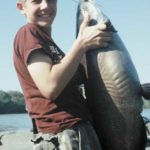
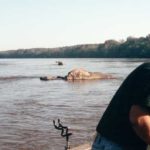
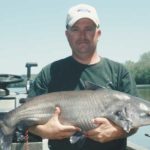
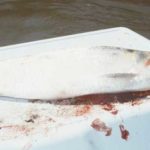
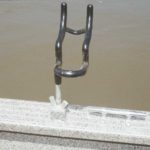
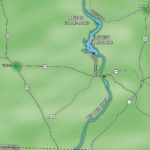


Be the first to comment